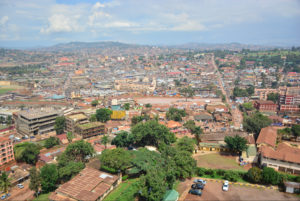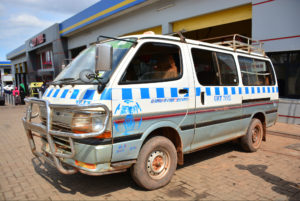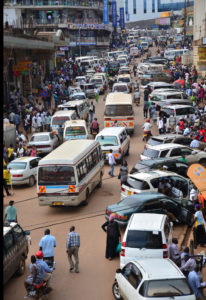Taxi life in Kampala
Taxi life in Kampala
Kampala is the capital of Uganda, a country in East Africa. The city has 1.2 million inhabitants and is the economic center of the country. Mellouki Cadat stayed at the beginning of June 2015 in Kampala and he explored how taxi’s operate in Kampala.
Formal public transportation is not provided in Kampala. Recently there have been plans to renew public transport, but these plans aren’t concrete yet. On a daily basis, there are thousands of taxis (minivans) driving through the city. The drivers are allowed to drive whenever they want.

Some drivers work from 7 am to the next morning, take a four-hour nap and then start driving again. To keep this routine up, they use Marunji (khat). This is very dangerous and many accidents happen.
Taxi drivers get a designated area where they are allowed to drive. For example, they may only drive on Gaddafi Road or Road Jinga to pick up customers. The Taxi Association (TA) monitors on the plots and checks the taxis. Every taxi has a number that is painted on the front, rear and sides of the car. This number matches a driver that is authorized to drive in a specific area. The TA consists of 500 committees of three members. Every location (there are at least 500 in the city) has its own committee. The committees elect the board of the TA. Most drivers drive for a employer. Some employers have a fleet of up to 50 taxis.

"According to my driver Abdul Masereka a taxi driver earns in average 80,000 Ugandan shillings (Ush) per day. That is € 23.50. Drivers do not need to take exams. A driver’s license is sufficient. They must buy a permit. The rate of this permit fee has gone up considerably. The rate has been multiplied twenty times within one year and is now € 44 per month in 2015. This fee has to be paid to the municipality. When a driver does not pay the fee, he risks being beaten up or ending up in jail".
There was considerable protest against the rate increase. During the protests the municipal authorities used tear gas and police batons. Some drivers and some board members of the TA were arrested and are still in prison.
The taxis don’t have a meter. As a customer, you should keep an eye on the mileage. The starting rate is 500 Ush (14 cents) and for every 0.5 kilometer 500 Ush has be paid. The night rate is 1000 Ush. The taxis are all Toyota minibuses. There is no fixed cab color but each car must paint a black belt around the car for recognition. Customers walk to the plots or hail a taxi on the street.

There is no taxi headquarter. Taxi drivers take calls on their mobile phones for pickups. The work is dangerous. For example, there are thieves posing as customers. They attack the chauffeur when they’re driving in remote locations. Abdul: ‘If you’re not killed, they’ll put you in a bag, drive you with another car hundreds of kilometres away and dump you there. Other dangers are the government, who picks up drivers and beat them up.’
Despite everything, Abdul finds his job as a taxi driver very pleasant. He loves the conversations with his customers and the solidarity among colleagues: they drive each other around for free.
Finally Mellouki writes: ‘At the checkpoint at the gate of Entebbe International Airport my fellow traveller and I had to get out of the car and walk through an electronic gate. The luggage was left in the taxi. The hand luggage was put in a basket, next to the gate and wasn’t checked. Meanwhile the taxi drove with the luggage past the checkpoint, without being checked. Later the driver told us that if we had given the gatekeepers 5,000 Ush we could’ve stayed in the taxi. It seems to be an additional check-up which was invented by the gatekeepers. They earn 300,000 Ush (€ 87) per month at the most. It is a way to earn a bit more.’
Correspondent: Mellouki Cadat
Taxi driver: Abdul Masereka (+256 782 417 579)
Photos: Yomi Hitijahubessy
Published on: Taxinummer 51
